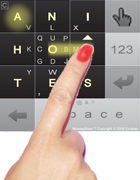Hi,
This is not really on-topic on the Colemak forum, but I figure people here may have interesting thoughts/opinions on this.
I recently jumped on the bandwagon and purchased an Android smartphone. After some initial dabbling with Qwerty, Colemak, T9 and Swype keyboards, I decided none of these are very efficient on a touch screen, particularly on a small 4" one. So I'm looking for alternatives.
There are plenty of "improved" keyboard apps available, for free or $$$, but most are just modifications/hacks/tweaks/improvements of the above, not fundamentally better (despite big claims and marketing statements). Two radically different alternatives caught my attention though, as they are specifically designed for touch screens: 8pen and MessagEase. I'm currently playing around with MessagEase, as it's a free download whereas 8pen is not.
In a nutshell: it's a matrix with 9 big keys, and a big space bar underneath. Tapping the 9 keys gives you the most frequent letters: ANIHORTES, the others are formed by "sliding" between keys (left/right, up/down, diagonally, and even back & forth). Visually:

My impressions so far:
PRO
+ designed from scratch specifically for touch screens, not improving on fundamentally inefficient methods
+ letter placement makes sense at first sight, most frequent letters require the least effort
+ large keys, especially the most frequent letters cannot be mistyped
+ there's a learning game with several levels and a speed test available
+ includes and even encourages a "blind" (unlabeled) keyboard mode, no hunt 'n peck!
+ many special characters available directly on corner keys (actually usable on a unix console!)
+ somewhat configurable, can implement "macros", but not change the layout
+ has a left-handed mode (putting the control keys on the left side)
+ several non-latin layouts (Russian etc) available as well
CON
– need to learn to type from scratch once again (but I actually wanted something completely different, right?)
– susceptible to typos by not clearing the finger enough between characters? (whereas eg. 8pen uses uninterrupted swipe patterns)
– patented, so no alternative implementations possible
– free download today but will it remain free?
– claims to be based on scientific research, but no white paper, no statistical evidence, not even arguments for the actual letter placement, are provided edit: there is a white paper
– little or no independent research
– will it even still exist two years from now? edit: already exists since 2003, so seems good
Thoughts? Experiences? Other alternatives?
